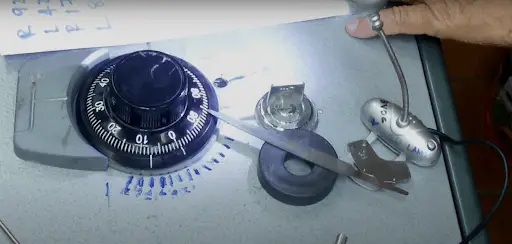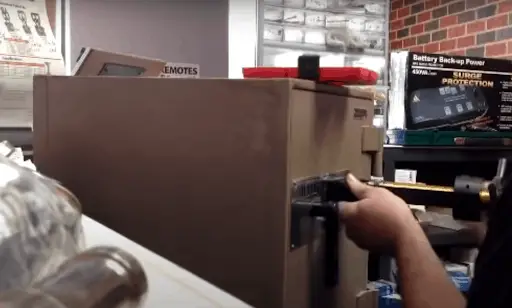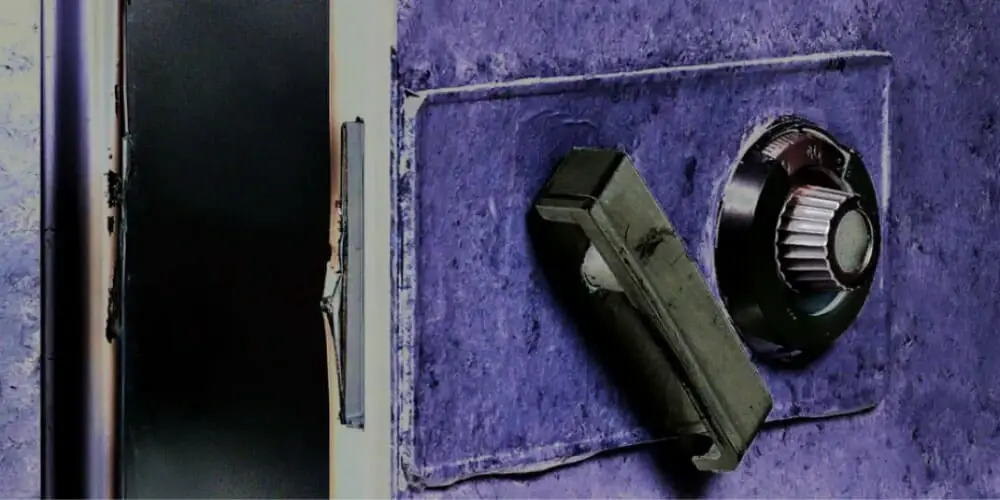When you’re missing your combination, there are several ways to gain access to that safe, including the following options.
- Reset the code and set up a new combination number. Call for a safe technician expert to override the digital pad. Or provide an emergency key.
- Get a locksmith who can retrieve the original code from the manufacturer.
- Extreme Option – have a locksmith drill the safe.
Before you get started looking at some options, keep in mind.
1. Safe boxes always come with an emergency keyhole. Locating them is tricky as they should not be visible to intruders and thieves.
2. Also, they should come with an emergency key.
Understanding your safes vault combination mechanism
Safes of different types come in two categories; dial and digital. They may differ in some features, but they both serve the same purpose: safeguarding your most valuable items.
A dial combination safe is a mechanical safe that locks and unlocks with a dial. It has been around for a hundred years and is manufactured by well-known safe makers.
I believe those dial safes are better than digital safes; for me, they are superior in the long run, but both are good keepers.
A dial safe is a locking device with an external dial that unlocks the door when a sequence of symbols, typically numerals, is turned. It has gained popularity among the general public since it is reliable and allows simple access to your safe without worrying about the battery life or power supply. A dial mechanical safe can still function in the case of a power loss.
With that said, A dial safe lasts far longer, and a high-quality dial safe is becoming more relevant with today’s technologies proving not to be as reliable when electronics fail. (1)
In comparison, a digital safe is an electronic safe. Business sectors typically favor a digital safe because it includes a programmable electronic keypad that assures secure, convenient, and quick operation. Some have a sophisticated light indication that flashes multiple colors to indicate different statuses.
A battery warning gauge and control operation signals will notify the user whether the safe is operating correctly and has high battery life.
How do you open a combination safe without the combination?
This question may arise if you have unexpectedly forgotten or misplaced your combination somewhere and are unsure what to do.
You might be stuck in this situation if you don’t know what you are doing.
Opening a dial safe

- The first step is to get the override or emergency key, overriding the safe’s combination. When you buy a safe, it comes with an override key as another method to open the vault. It would help if you kept the emergency key secure.
- Now, look for the little round notch. It is usually located just beneath the safe’s dial. Or perhaps a concealed small aperture on the panel that covers the safe’s dial. So, by removing the board, you may access the notch. Side note: The notch is known as the emergency keyhole. It often blends in with the safe so that no one notices it.
- After locating the notch, remove the cover to reveal the tiny keyhole. Some emergency keyholes are on the side of the dial.
- Finally, insert the key into the small keyhole and turn it until the safe is open. Remember to restore the key to its original place before removing it; otherwise, the safe will fail the next time you use it.
- If you misplace the emergency key and your safe door is locked, and there is no way to access it, you must contact the safe’s manufacturer.
Opening a digital safe
Note that this method will work for many safes in general, but you will probably want to find documentation for your specific model. Most safes will follow the below formula.
- Locate the bolt’s opening at the rear of the safe with a flashlight. On the other hand, smaller electronic safes have a hole at the back or bottom.
- Once you’ve found the bolt opening, shine your flashlight through it.
- Look for the back panel, which houses the safe’s electronic components. It has an internal keypad as well as a few additional control buttons.
- Use a long, slim stick or anything thin, straight, and rigid enough to fit through the bolt opening.
- Use the stick and hit the red button to reset the code on your safe. Hold it for around 10 seconds.
- Enter the new combination code on the inside keypad after resetting the code. Remember or write down the new code.
- After that, use the stick to press the set button next to the reset button.
- Then you’ll hear a beep, indicating that the attempt to replace the safe combination was successful.
Drill open the bolt

Using brute force is a traditional method for unlocking a safe with an unknown combination. Drilling is the most common approach. It entails drilling a tiny hole and breaking the lock from the inside.
However, most advanced safes can resist such a procedure, implying that drilling is mainly helpful for older safes. Then you’ll need a locksmith to get the job done correctly.
Calling in a Locksmith
Locksmiths nowadays are engaged in the installation of first-rate locksets as well as the treatment of keying systems. And one of their specialties is accessing a safe without a combination.
To get into your safe, you can use a locksmith to:
- Get an override key: The locksmith can get a copy of it or make one from scratch.
- Retrieve the combination: The locksmith may retrieve the original code combination or reset your password.
- Break into the safe quickly, especially if you own an expensive model.
- Drill and repair the safe safely: The locksmith is well-versed in drilling techniques. The locksmith can locate the drill points from the safe and know where to drill so that none of the safe’s security features are triggered. You can spend extra money repairing the safe to its original working condition.
Opening a safe without the combination is tricky, but it doesn’t mean you can’t. With tips and tricks like using the emergency keyhole, you can open a combination safe without a combination. After all, getting a locksmith is still the best last Option.
Would you please let us know what you think of this guide in the comment section? We would appreciate it if you could share this post too.
Reference
(1) electronics – https://www.britannica.com/technology/electronics

